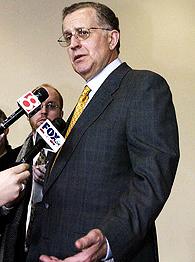Cbz40
The Grand Poobah
- Messages
- 31,387
- Reaction score
- 39
What if the NFL had not adopted a system of free agency?
ESPN.com
The NFL staff has identified plays or events that may have altered the course of history. Each Tuesday and Saturday throughout the offseason, we will be tackling a different scenario and speculate on how things might have gone differently.
Perhaps no league features as much player movement as the NFL, but that wasn't always the case. For decades, players fought to achieve freedom. The breakthrough finally came, ironically enough, as a result of the failed strike in 1987, and the consequences have forever altered the landscape of the league.

Paul Tagilabue was forced to finally give in to the demands of the players.
The NFL Players Association was formed in 1956, but struggled to gain the respect of the the league's owners and executives. Nevertheless, the threat of antitrust litigation helped the union win certain benefits through the years, including a pension, health insurance plan, and payment for exhibition games. It also eliminated the Rozelle Rule, which barred players from moving to another team after their contracts expired.
Despite two lengthy work stoppages (in 1982 and 1987), little progress was made in the area of free agency. In 1989, the union was formally decertified, converting into a professional association. In turn, union members brought a new antitrust action against the NFL challenging its free agency rules as an unlawful restraint of trade.
The players prevailed in a jury trail, and the verdict left the league with little choice but to agree on a formula that permitted free agency, in return for salary caps tied to a formula based on players' share of total league revenues. As rosters change every year and fewer players finish their careers with the team that drafted them, it is fair to wonder what the NFL would look like today without free agency?
-- David Mosse
ESPN.com
The NFL staff has identified plays or events that may have altered the course of history. Each Tuesday and Saturday throughout the offseason, we will be tackling a different scenario and speculate on how things might have gone differently.
Perhaps no league features as much player movement as the NFL, but that wasn't always the case. For decades, players fought to achieve freedom. The breakthrough finally came, ironically enough, as a result of the failed strike in 1987, and the consequences have forever altered the landscape of the league.

Paul Tagilabue was forced to finally give in to the demands of the players.
The NFL Players Association was formed in 1956, but struggled to gain the respect of the the league's owners and executives. Nevertheless, the threat of antitrust litigation helped the union win certain benefits through the years, including a pension, health insurance plan, and payment for exhibition games. It also eliminated the Rozelle Rule, which barred players from moving to another team after their contracts expired.
Despite two lengthy work stoppages (in 1982 and 1987), little progress was made in the area of free agency. In 1989, the union was formally decertified, converting into a professional association. In turn, union members brought a new antitrust action against the NFL challenging its free agency rules as an unlawful restraint of trade.
The players prevailed in a jury trail, and the verdict left the league with little choice but to agree on a formula that permitted free agency, in return for salary caps tied to a formula based on players' share of total league revenues. As rosters change every year and fewer players finish their careers with the team that drafted them, it is fair to wonder what the NFL would look like today without free agency?
-- David Mosse

